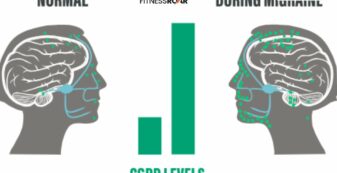Shingles on the Neck: Symptoms, Treatment, and Prevention

Understanding Shingles on the Neck

Shingles, also known as herpes zoster, is a reactivation of the varicella-zoster virus, the same virus that causes chickenpox. After a person recovers from chickenpox, the virus can lie dormant in nerve cells for years. When it reactivates, it travels along nerve pathways to the skin, causing a painful rash with blisters. This rash can appear in various areas of the body, including the neck.
Also Read: Foods That Help You Get Better Sleep
Symptoms of Shingles on the Neck
Shingles, a reactivation of the varicella-zoster virus (chickenpox), can cause a painful rash with blisters. While shingles typically develop on the torso, it can also affect the neck. Here’s what to watch out for if you suspect shingles on your neck:
Early Warning Signs:
Even before the rash appears, you might experience discomfort in the affected area, including the neck. This can include:
- Pain
- Burning sensation
- Tingling
The Shingles Rash:
The hallmark symptom of shingles is a rash that usually forms in a stripe or band on one side of the body, following the path of affected nerves. On the neck, this might appear as a band wrapping around one side of your neck. The rash itself progresses through stages:
Red, inflamed skin: The initial stage is marked by redness and inflammation of the skin.
Fluid-filled blisters: Small, itchy, fluid-filled blisters erupt on the reddened area.
Crusting and scabbing: The blisters eventually break open and crust over, forming scabs.
Important to Note:
It’s important to remember that shingles symptoms typically affect only one side of the body. So, in the case of shingles on the neck, the rash and discomfort would likely be on one side of your neck only.
If you’re experiencing any of these symptoms, especially the burning or tingling before the rash appears, it’s crucial to see a doctor right away. Early diagnosis and treatment can help shorten the duration of the outbreak and reduce the risk of complications, such as postherpetic neuralgia (long-term nerve pain).
Also Read: Managing Seasonal Influenza
Treatment for Shingles on the Neck
While shingles on the neck can be uncomfortable, there are effective treatments available to help you manage the symptoms and shorten the course of the outbreak. Here’s an overview of what you can expect:
Early Intervention is Key:
The most crucial step is to see a doctor as soon as possible, ideally within 72 hours of noticing the first symptoms. Early diagnosis allows for prompt treatment, which can significantly improve your outcome and reduce the risk of complications.
Antiviral Medications:
Your doctor will likely prescribe antiviral medications like acyclovir, valacyclovir, or famciclovir. These medications work by targeting the varicella-zoster virus, helping to shorten the duration and severity of the outbreak.
Pain Management:
Shingles can be quite painful, especially on sensitive areas like the neck. To manage the pain, your doctor might recommend over-the-counter pain relievers like ibuprofen or acetaminophen. In some cases, stronger pain medication might be necessary.
Soothing the Itch:
The rash caused by shingles can be very itchy. To alleviate the discomfort, your doctor might suggest applying calamine lotion or using cool compresses on the affected area. Oatmeal baths can also provide relief.
Additional Considerations:
Protecting the Rash: It’s important to keep the rash clean and prevent scratching, which can increase the risk of infection and scarring.
Post-Herpetic Neuralgia: In some cases, shingles can lead to a complication called postherpetic neuralgia, which is long-term nerve pain that persists even after the rash clears. Early treatment of shingles can help reduce the risk of developing this complication.
By seeking medical attention promptly and following your doctor’s treatment plan, you can effectively manage shingles on the neck and promote a faster recovery.
Differences Between Shingles and Other Rashes
Shingles on the neck can sometimes be mistaken for other skin conditions that cause rashes. Here’s how to distinguish shingles from some common imposters:
The Shingles Signature:
Shingles has some unique characteristics that set it apart from other rashes. These include:
Distinct Pattern: The rash caused by shingles typically follows a nerve pathway, forming a stripe or band that wraps around one side of the body. This is in contrast to other rashes that might be more scattered or appear on both sides of the neck.
Early Warning Signs: Often, even before the rash appears, shingles causes pain, burning, or tingling sensations in the affected area. This early warning sign is less common with other rashes.
Common Look-Alikes:
While shingles has its own tell-tale signs, there are a few rashes that might appear similar on the neck:
Contact Dermatitis: This itchy, red rash is caused by direct contact with an irritant or allergen. Unlike shingles, it usually appears on the area that directly touched the irritant and doesn’t follow a nerve pathway.
Eczema: This chronic skin condition causes dry, itchy, and inflamed patches of skin. Eczema can appear on the neck but generally doesn’t have the blistering or one-sided distribution characteristic of shingles.
Hives: These raised, welty bumps can appear anywhere on the body, including the neck. However, hives are typically not painful and tend to come and go quickly, unlike the persistent rash and pre-rash discomfort of shingles.
Remember: If you’re unsure about a rash on your neck, it’s always best to consult a doctor for an accurate diagnosis. They can examine the rash and take your medical history into account to determine the cause and recommend the appropriate treatment.
Also Read: Foods for a Healthy Sex Life
In Crux
Shingles, a reactivation of the chickenpox virus, can cause a painful rash with blisters. While shingles typically develop on the torso, it can also affect the neck. Recognizing the signs and symptoms is crucial for early diagnosis and effective treatment.
If you suspect shingles on your neck, it’s vital to see a healthcare professional as soon as possible. Early intervention allows for prompt treatment, leading to faster recovery and a lower risk of complications. Don’t hesitate to consult your doctor – they can provide an accurate diagnosis and guide you towards the most effective treatment plan for shingles on the neck.
How much did you like Our detailed Shingles on the Neck: Symptoms, Treatment, and Prevention? Please share your view in the comment box. Also, please share these Blogs with your friends on social media.
Recommended
RELATED ARTICLES

Buspar and Alcohol Interaction

Ubrelvy Side Effects: Risks and Benefits

How Swimming Strengthens Abs

Best Nutrition Guide for Runners

Understanding Suprapubic Pain

Impressive Benefits of Neem

Skinny fat is a sign of dementia!

Yoga Poses to Help You With Constipation

Interesting Benefits of Water Aerobics

Tips To Deal with Post-Lockdown Anxiety







